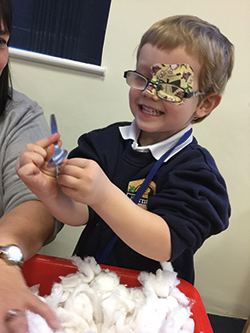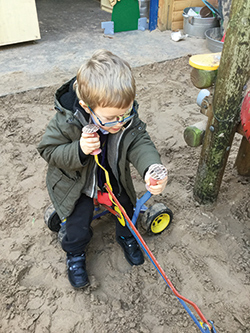
William King is a very happy, dinosaur-loving three-year-old, who has epilepsy. William attends Barnton Community Nursery & Primary School, along with his older brother Jenson, who also has epilepsy.
‘William has been with us for a year and a half,’ says Debs Stewart, assistant head teacher at Barnton. ‘He joined us as a funded two-year-old and has moved now to the main nursery setting. He is a very happy, settled little boy who often carries around a dinosaur or one of the animals from the small-world play.’
Epilepsy is a life-threatening condition that affects the brain – people with epilepsy have a tendency to have epileptic seizures. There are many different types of seizure, and what happens during one depends on what part of the brain is affected.
William has absence and partial seizures. A typical absence seizure consists of a sudden loss of awareness: the child will stop what they are doing, stare blankly into space, and will not respond to people talking to them. An absence seizure usually lasts between five and 15 seconds and generally stops as suddenly as it starts, with the child resuming their normal activities.
In partial seizures, epileptic activity starts in just one area of a person’s brain. The child may remain alert or they may not be aware of what is happening. Signs can include unusual body movements, repeatedly chewing, swallowing, fumbling with their buttons, screaming or crying out. They may not be able to speak or understand what is being said, and they may wander off without knowing where they are going or what they are doing.
In addition to absence and partial seizures, William has pica, an eating disorder that makes him crave non-food substances. He needs constant supervision. ‘When he arrived at nursery he would pick out tufts of carpet and try to eat them, but he hasn’t done that for a while now,’ says Ms Stewart. ‘The symptoms are more apparent when he is nervous or undergoing change. He is just like any other child, happy and jolly, and copes extremely well with his condition, but he does have the odd seizure when he is with us and can become quite tired.’
While at nursery, William is closely monitored, so staff are instantly alerted if he does have a seizure, and also to prevent him from harming himself by eating non-food items.
‘The biggest challenge is making sure that one person is always 100 per cent aware of where William is; especially as he is in a nursery environment where there are dens, he can hide around corners, and there are 37 other children around,’ says Ms Stewart.
ANNUAL TRAINING
 Nursery staff undergo annual training from a specialist nurse, which takes place on the inset day before the start of the academic year. The training is arranged by William’s mother, Rachael, who also regularly comes in to update practitioners on her boys’ condition. ‘During training we have learnt what might trigger a seizure, how seizures are more likely to occur when William is tired or excited, for example, and what to do if one occurs,’ says Ms Stewart.
Nursery staff undergo annual training from a specialist nurse, which takes place on the inset day before the start of the academic year. The training is arranged by William’s mother, Rachael, who also regularly comes in to update practitioners on her boys’ condition. ‘During training we have learnt what might trigger a seizure, how seizures are more likely to occur when William is tired or excited, for example, and what to do if one occurs,’ says Ms Stewart.
Rachael has also put together an in-depth booklet about epilepsy which she has shared with staff across the school. Family relationships are key, and Rachael, who knew the staff following her older son’s time in the nursery, was able to request a specific keyworker for him.
If William does have a seizure, staff make sure he is safe and can’t fall and hurt himself. They also set a timer. ‘All seizures need to be timed, to inform parents of length,’ says Ms Stewart. ‘We would then ring the parents and follow their guidance.’
The nursery does not get any additional funding for supporting William. In terms of specialist equipment, he has a ‘chewbuddy’, a colourful plastic pendant which he can chew. He also has a sticky eye patch, which needs to be placed over his eye every day. At the end of the day, the eye patch is placed on a sticker chart.
The setting makes sure it handles William’s transitions with care, to make them as low-key as possible, as stress can trigger seizures. ‘Before he moved from the two-year-old room to the main nursery, he visited a lot, and would spend at least one afternoon a week there so he knew everybody by the time he moved up,’ explains Ms Stewart.
It is not just William the nursery works to reassure, but also his mother, who is understandably anxious about her son. ‘The biggest thing is getting mum to trust us, so we put things in place to make sure she is happy, showing her that William knows the staff, where the toilets are and so on,’ says Ms Stewart.
The next step will be William’s transition to Reception, which will be handled in a similar way, with plenty of visits to the classroom and photographs and booklets sent home to familiarise William and his mother with the new environment.
William has attended many of the nursery’s trips, including to a farm and an airport. While out of the nursery, the close monitoring by staff continues, as do their efforts to include and reassure William’s mum. ‘We make sure we send his mum pictures while we are out, showing that he is fine,’ says Ms Stewart. ‘While we are out on trips, we make sure William is with his keyworker, not with an adult who doesn’t know him.’
 Nursery has allowed William to develop independence, as well as giving Rachael time to enjoy being with his baby sister. ‘He loves praise and recently received the head teacher’s award,’ says Ms Stewart. ‘He went up to get it in front of everybody, which is challenging for him as he doesn’t always like being on stage. He is developing his number skills and joins in the Jolly Phonics, and is also developing his fine motor skills.’
Nursery has allowed William to develop independence, as well as giving Rachael time to enjoy being with his baby sister. ‘He loves praise and recently received the head teacher’s award,’ says Ms Stewart. ‘He went up to get it in front of everybody, which is challenging for him as he doesn’t always like being on stage. He is developing his number skills and joins in the Jolly Phonics, and is also developing his fine motor skills.’
Staff also ensure other pupils in the school understand what epilepsy is and how it affects William and his brother Jenson. This means that the boys can learn and play with their fellow classmates without feeling different or isolated.
The school held a special day in March last year to mark Purple Day, a global day for epilepsy, in order to raise further awareness among staff and pupils.
Rachael says she is very appreciative of the support her son receives. She says, ‘It is a huge step when starting nursery or school, especially with a child who has additional needs. I am so lucky to have the support, dedication and passion of the staff who work within the nursery. They work closely with William to overcome any challenges and to keep him safe at all times, and the progress he has already made is outstanding.
‘His keyworker, Mrs Shaw, communicates well on a daily basis with us, as do the whole team, and we get brilliant support too from Ms Stewart. As a parent, the main thing you want is the best start for your child in life within education, and I feel very lucky to have such a hardworking team looking after William.’
CHILDREN AND EPILEPSY
- There are approximately 42,000 children under 16, or one in 279, with epilepsy in the UK.
- On average, there will be one child with epilepsy in every primary school and five in every secondary school.
- It will cost £15 billion to treat the total current UK population of children with epilepsy during their lifetimes. This figure does not include social services and educational costs. This is equivalent to £0.5 billion per annum to treat children with epilepsy.
- Children with epilepsy frequently underachieve at school: 50 per cent achieve less than would be predicted from their IQ.
- There are around 40 different types of seizure, and a person may have more than one type.
Figures from Epilepsy Action
THE EDWARDS
Barnton Community Nursery & Primary School was one of the winners of last year’s Edwards awards, set up by charity Epilepsy Action to celebrate the nation’s ‘epilepsy education superstars’. Settings that win an award are judged to have gone above and beyond in supporting children with epilepsy. William’s mother Rachael King nominated the setting for its support of William and his brother Jenson.
Epilepsy Action hopes to encourage nurseries, schools, colleges and universities to adopt a person-centred approach to learning. It wants children with epilepsy to grow in confidence, feel part of their community and be effectively supported to reach their potential.
Other winners last year included Banks Road Infant and Nursery School in Nottingham, and Hillside Play Centre in Southminster, Essex.
Anyone can nominate a nursery, school or college for an Edwards award. People can sign up to the Epilepsy Action newsletter to find out when nominations open at epilepsy.org.uk/newsletter, or follow the charity on Facebook and Twitter @epilepsyaction).
MORE INFORMATION
Epilepsy Action’s website has some animations about children with the condition which are suitable for older nursery children, www.epilepsy.org.uk/info/children/animations-for-children
The charity also has a free range of training resources for people working in schools, http://learn.epilepsy.org.uk/training-for-schools
Purple Day is a fundraising and awareness-raising day which takes place in March, www.purpleday.org
The NHS has information about epilepsy, www.nhs.uk/Conditions/Epilepsy/Pages/Introduction.aspx









